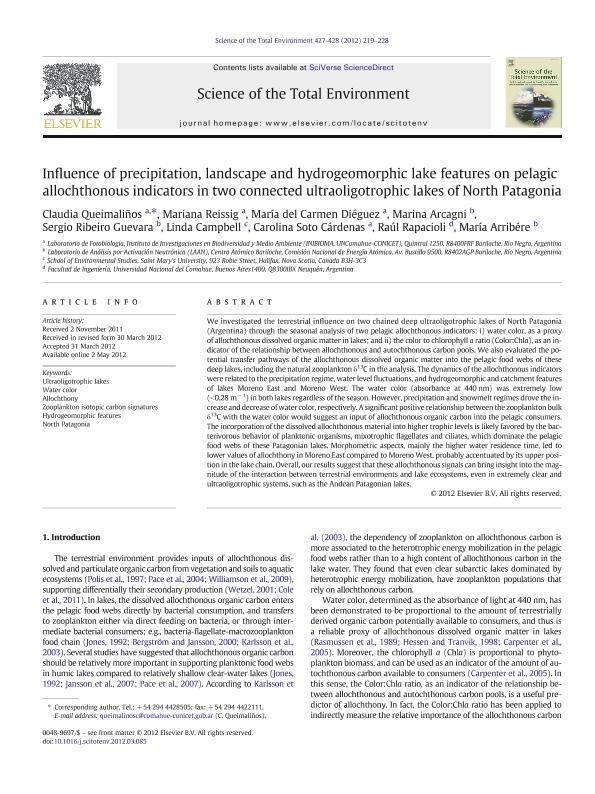Artículo
Influence of precipitation, landscape and hydrogeomorphic lake features on pelagic allochthonous indicators in two connected ultraoligotrophic lakes of North Patagonia
Queimaliños, Claudia Patricia ; Reissig, Mariana
; Reissig, Mariana ; Dieguez, Maria del Carmen
; Dieguez, Maria del Carmen ; Arcagni, Marina
; Arcagni, Marina ; Ribeiro, Sergio; Campbell, Linda; Soto Cárdenas, Estela Carolina
; Ribeiro, Sergio; Campbell, Linda; Soto Cárdenas, Estela Carolina ; Rapacioli, Raúl; Arribere, Maria Angelica
; Rapacioli, Raúl; Arribere, Maria Angelica
 ; Reissig, Mariana
; Reissig, Mariana ; Dieguez, Maria del Carmen
; Dieguez, Maria del Carmen ; Arcagni, Marina
; Arcagni, Marina ; Ribeiro, Sergio; Campbell, Linda; Soto Cárdenas, Estela Carolina
; Ribeiro, Sergio; Campbell, Linda; Soto Cárdenas, Estela Carolina ; Rapacioli, Raúl; Arribere, Maria Angelica
; Rapacioli, Raúl; Arribere, Maria Angelica
Fecha de publicación:
07/2012
Editorial:
Elsevier Science
Revista:
Science of the Total Environment
ISSN:
0048-9697
Idioma:
Inglés
Tipo de recurso:
Artículo publicado
Clasificación temática:
Resumen
We investigated the terrestrial influence on two chained deep ultraoligotrophic lakes of North Patagonia (Argentina) through the seasonal analysis of two pelagic allochthonous indicators: i) water color, as a proxy of allochthonous dissolved organic matter in lakes; and ii) the color to chlorophyll a ratio (Color:Chla), as an indicator of the relationship between allochthonous and autochthonous carbon pools. We also evaluated the potential transfer pathways of the allochthonous dissolved organic matter into the pelagic food webs of these deep lakes, including the natural zooplankton δ 13C in the analysis. The dynamics of the allochthonous indicators were related to the precipitation regime, water level fluctuations, and hydrogeomorphic and catchment features of lakes Moreno East and Moreno West. The water color (absorbance at 440nm) was extremely low (<0.28m -1) in both lakes regardless of the season. However, precipitation and snowmelt regimes drove the increase and decrease of water color, respectively. A significant positive relationship between the zooplankton bulk δ 13C with the water color would suggest an input of allochthonous organic carbon into the pelagic consumers. The incorporation of the dissolved allochthonous material into higher trophic levels is likely favored by the bacterivorous behavior of planktonic organisms, mixotrophic flagellates and ciliates, which dominate the pelagic food webs of these Patagonian lakes. Morphometric aspects, mainly the higher water residence time, led to lower values of allochthony in Moreno East compared to Moreno West, probably accentuated by its upper position in the lake chain. Overall, our results suggest that these allochthonous signals can bring insight into the magnitude of the interaction between terrestrial environments and lake ecosystems, even in extremely clear and ultraoligotrophic systems, such as the Andean Patagonian lakes. © 2012 Elsevier B.V.
Archivos asociados
Licencia
Identificadores
Colecciones
Articulos(INIBIOMA)
Articulos de INST. DE INVEST.EN BIODIVERSIDAD Y MEDIOAMBIENTE
Articulos de INST. DE INVEST.EN BIODIVERSIDAD Y MEDIOAMBIENTE
Citación
Queimaliños, Claudia Patricia; Reissig, Mariana; Dieguez, Maria del Carmen; Arcagni, Marina; Ribeiro, Sergio; et al.; Influence of precipitation, landscape and hydrogeomorphic lake features on pelagic allochthonous indicators in two connected ultraoligotrophic lakes of North Patagonia; Elsevier Science; Science of the Total Environment; 427-428; 7-2012; 219-228
Compartir
Altmétricas



